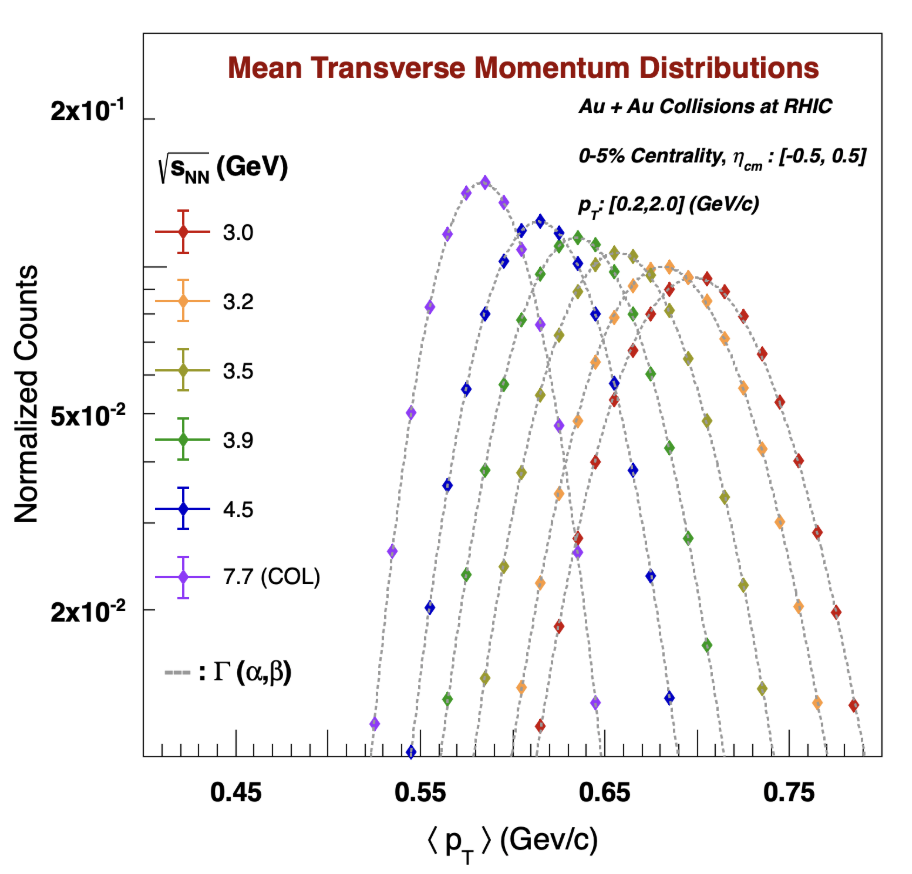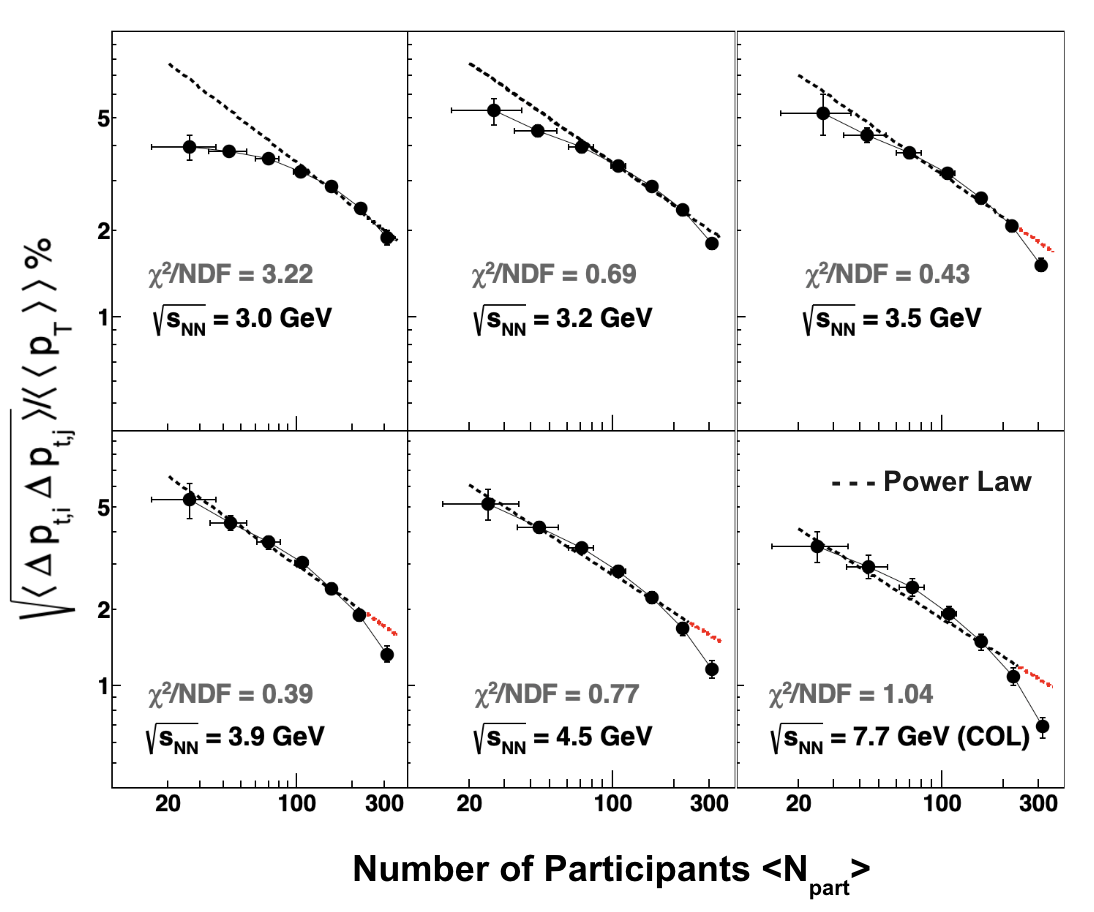Paper proposal for pt Correlations in Au + Au Collisions in the High Baryon Density Region
Paper Title : Non-Monotonicity of pT Correlations in Au + Au Collisions at RHIC
Target Journal : PRL
PAs : Rutik Manikandhan, Rene Bellwied, Anthony Timmins, Caleb Broodo, Aranya Giri, Chun-Jian Zhang, Jinhui Chen
PA representative : Rutik Manikandhan
//-------------------------------------------------------------------------------------------
Abstract:
We report the first measurements of two-particle transverse momentum correlations for mid-rapidity charged particles in Au+Au collisions at $\sqrt{s_{NN}}$ = 3.0, 3.2, 3.5, 3.9, 4.5, and 7.7 GeV measured by the STAR experiment. In addition, we present the uncorrected event-by-event distributions of the average transverse momentum at these energies. The results are compared to previous STAR measurements from the Beam Energy Scan Phase I (BES-I) and to model calculations from UrQMD and AMPT.
The measured two-particle $p_T$ correlators exhibit an approximate power-law dependence on the number of participating nucleons ($N_{\text{part}}$), consistent with expectations from an independent source scenario. Importantly, a non-monotonic energy dependence of the $p_T$ correlations is observed in central collisions.
This represents the first systematic observation of such behavior as a function of collision energy. Further insight from dynamical model calculations incorporating a QCD critical point is needed to interpret the observed behavior.
//-------------------------------------------------------------------------------------------
Paper Figures:

Fig 1: The efficiency uncorrected density distribution in transverse momentum ($p_{T}$) and particle pseudorapidity ($\eta_{lab}$) in lab frame within 0-5% centrality Au+Au
collisions measured with STAR TPC in Au+Au collisions at $\sqrt{s_{NN}}$ = 3.0,3.2,3.5,3.9,4.5 & 7.7 (Collider) GeV. The dashed blue lines are midrapidity at each energy
and the black window is the analysis window.Note that the density distribution is self-normalized in each panel.

Fig 2 : Histograms of the uncorrected average transverse momentum per event for Au+Au collisions at √sNN = 3.0, 3.2, 3.5, 3.9, 4.5 and 7.7 GeV (COL) for the 5% most central collisions at each energy. The dashed line represents gamma distribution fits.

Fig 4 : The relative dynamical correlation, $\sqrt{\langle \Delta p_{t,i} \Delta p_{t,j} \rangle} / \langle\langle p_{t} \rangle\rangle$, is presented as a function of $N_{\text{part}}$ for six collision energies, using centrality bins of 10%. Statistical and systematic errors are shown. The solid straight lines represent a power law. All of these measurements are done within the same $p_{T}$ acceptance of [0.2,2.0] GeV/c and pseudorapidity ($\eta$) acceptance of $|\eta_{cm}|$ < 0.5, where \eta_{cm} = \eta_{lab} - \eta_{mid}.

Fig. 4 : The two particle $p_{T}$ correlator as a function of collision energy $sqrt{s_{NN}}$ in Au+Au 0-5% central collisions. Statistical and systematic uncertainties are shown as
bars and gray bands, respectively. Note that for all the measurements the charged particles are selected within a $p_{T}$ acceptance of [0.2,2.0] GeV/c and pseudorapidity ($\eta$)
acceptance of $|\eta_{cm}|$ < 0.5, where \eta_{cm} = \eta_{lab} - \eta_{mid}. UrQMD calculations are shown as red band, modified AMPT calculations are shown as pink
band.
//-------------------------------------------------------------------------------------------
Conclusions:
In Summary, we report measurements of the relative dynamical correlation, $\sqrt{\langle \Delta p_{t,i} \Delta p_{t,j} \rangle}/\langle\langle p_{t} \rangle\rangle$, in Au+Au collisions over a broad range of center-of-mass energies from 3 GeV to 7.7 GeV, corresponding to a baryon chemical potential ($\mu_B$) range of 760 MeV to 400 MeV. In addition, we present histograms of the event-by-event mean transverse momentum, $\langle p_T \rangle$, providing direct access to the underlying fluctuation distributions. The observed power-law scaling behavior of the relative dynamical correlation exhibits systematic deviations with collision energy, identifying a region where the scaling breaks down. For the first time, we observe a non-monotonic dependence of the relative dynamical correlation in central collisions as a function of collision energy, emerging within the energy range where the QCD critical point is predicted. These results provide new experimental evidence for the possible onset of critical behavior in strongly interacting matter.
//-------------------------------------------------------------------------------------------
Presentations:
PWGC presentation:
https://drupal.star.bnl.gov/STAR/system/files/PWGC%20preview%20%281%29.pdf
Presentations at the BES-II Workshop 2024:
https://drupal.star.bnl.gov/STAR/system/files/Rutik_BES-II_WorkshopClosed.pdf
https://drupal.star.bnl.gov/STAR/system/files/Rutik_BES-II_workshop.pdf
Oral Talk at FAIRNess 2024:
https://indico.gsi.de/event/18746/contributions/82724/attachments/48699/70721/FAIRNess%202024%20%284%29.pdf
Oral Talk at CPOD 2024:
https://conferences.lbl.gov/event/1376/contributions/8802/attachments/5149/4966/Rutik_CPOD_Final.pdf
Talks at STAR Collaboration Meetings:
October 2024 : https://drupal.star.bnl.gov/STAR/system/files/STARCollaborationMeeting_0.pdf
March 2024 : https://drupal.star.bnl.gov/STAR/system/files/CollaborationMeeting32923.pdf
Presentations for Preliminary request:
3.0 GeV :
https://drupal.star.bnl.gov/STAR/system/files/Correlationsat3GeV.pdf
3.2 GeV:
https://drupal.star.bnl.gov/STAR/system/files/Preliminary.pdf
3.5,3.9 & 7.7 GeV:
https://drupal.star.bnl.gov/STAR/system/files/Prelim_all_energies.pdf
- rutikmani's blog
- Login or register to post comments
